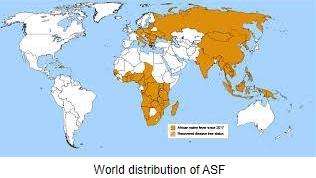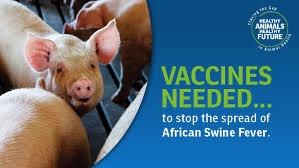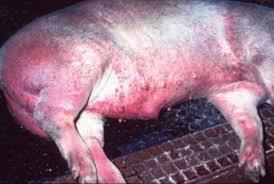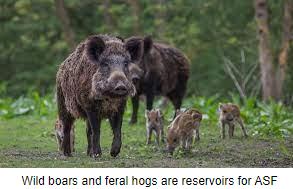 Dr. Dermot Hayes, an Economist at Iowa State University, has projected the financial impact of introduction of African swine fever (ASF) if this infection enters the U.S. pork industry. It is estimated that pork and to a lesser extent, the beef industries would experience an $80 billion loss. This would arise from depopulation of herds, a precipitous drop in export volume with diversion of pork to the domestic market, reducing wholesale prices. Even if controlled, the effects would persist in excess of three years. It is estimated that 60,000 industry workers would be threatened with job losses.
Dr. Dermot Hayes, an Economist at Iowa State University, has projected the financial impact of introduction of African swine fever (ASF) if this infection enters the U.S. pork industry. It is estimated that pork and to a lesser extent, the beef industries would experience an $80 billion loss. This would arise from depopulation of herds, a precipitous drop in export volume with diversion of pork to the domestic market, reducing wholesale prices. Even if controlled, the effects would persist in excess of three years. It is estimated that 60,000 industry workers would be threatened with job losses.
The review of the Iowa State report by Jennifer Shike in a May 18th posting in Pork-Farm Journal notes that preventive measures do not address the entire financial impact of  ASF). Given the projection by Dr. Hayes, it is suggested that prevention should be the major immediate objective requiring investment in programs that will interdict ASF virus at points of entry to the U.S. Unlike HPAI in the poultry industry, pork producers are in the favorable situation that hogs do not fly. This said, surveillance at points of entry including airports and harbors must be intensified. It is noted that ASF initial was introduced to Portugal and Spain in the 1950s through discarded food from a flight from Angola to Lisbon. Eradication of the initial outbreak and the subsequent 1960 cases that extended to France took more than a decade to eradicate.
ASF). Given the projection by Dr. Hayes, it is suggested that prevention should be the major immediate objective requiring investment in programs that will interdict ASF virus at points of entry to the U.S. Unlike HPAI in the poultry industry, pork producers are in the favorable situation that hogs do not fly. This said, surveillance at points of entry including airports and harbors must be intensified. It is noted that ASF initial was introduced to Portugal and Spain in the 1950s through discarded food from a flight from Angola to Lisbon. Eradication of the initial outbreak and the subsequent 1960 cases that extended to France took more than a decade to eradicate.
The USDA could train and deploy many more beagles to avoid an $80 billion loss. Surveillance of passenger luggage at the airports at Bangkok, Singapore and Taipei have revealed widespread, inadvertent or deliberate smuggling of raw and partly cooked pork products that have yielded a ASF virus. Given that African swine fever is endemic in many Asian nations but also in Haiti and the Dominican Republic, special attention should be paid to incoming flights from these nations The problem of smuggling large quantities of traditional pork products from Asia in shipping containers is more difficult to prevent but again, the risks and consequences of introducing infection justify enhanced surveillance.

The National Pork Board has introduced AgView, a database and dashboard program, that will track movement of affected hogs in the event of a possible outbreak. Traceability is an important consideration and records of the movement of herds will be critical to effective control of any outbreak. It is presumed that the pork industry and designated diagnostic laboratories have developed the ability to rapidly diagnose and report outbreaks of ASF paralleling the experience gained with HPAI.
 Research on the persistence of ASF virus in grains and oilseeds and sacking have demonstrated the potential of introducing infection through imported feed ingredients. Given the ability of ASF to withstand high temperatures, it is questioned whether the U. S. should import any ingredient from a nation with endemic or suspected ASF other than vitamin and mineral additives derived from pharmaceutical plants operating under good manufacturing practices.
Research on the persistence of ASF virus in grains and oilseeds and sacking have demonstrated the potential of introducing infection through imported feed ingredients. Given the ability of ASF to withstand high temperatures, it is questioned whether the U. S. should import any ingredient from a nation with endemic or suspected ASF other than vitamin and mineral additives derived from pharmaceutical plants operating under good manufacturing practices.
EGG-NEWS has frequently pointed to the dangers of feral hogs serving as reservoirs of ASF. The extent and number of free-living hogs will contribute to persistence of infection and mitigate against eradication as evidenced in western Europe. A concerted program to eliminate feral hogs should be implemented since current programs conducted under state and Federal support are obviously inadequate to prevent extension of current populations of feral hogs.
It is self-evident that in the event of introduction of ASF into the U. S., an effective and safe vaccine will be required as an adjunct to slaughtering of affected herds. The USDA gained considerable publicity following the announcement of a claimed effective vaccine developed by the ARS at the Plum Island research laboratory. It is understood that this vaccine has been field tested in Viet Nam albeit with variable results. The question is now posed as to whether this or other vaccines are effective in controlling the disease. If so, stockpiles should be established. If the vaccine is ineffective, then an alternative is obviously required.
It is hoped that USDA and the organized pork industry will learn from the experiences of poultry producers in the U. S. and worldwide regarding suppression but not eradication of HPAI.